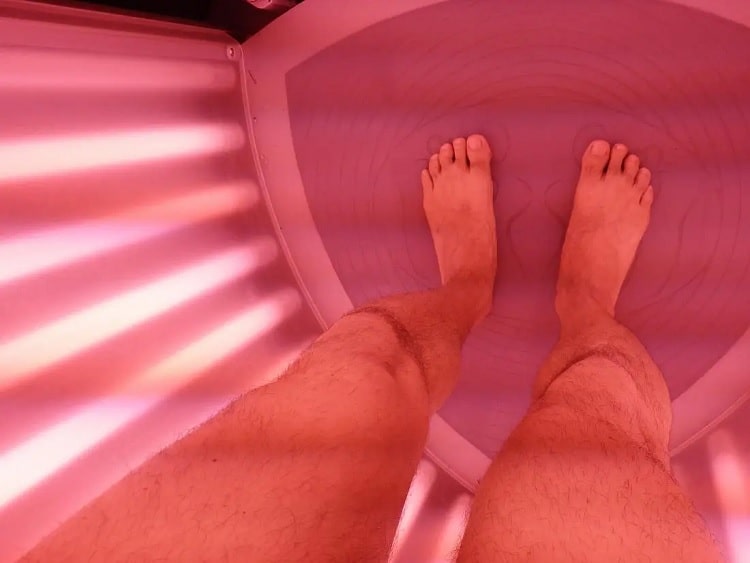Does Red Light Therapy Work for Weight Loss?
Better known as low-level laser therapy (LLLT) or red light therapy, red light has been touted by some as a home projector of health benefits. People suggest it can ease back and neck pain, reduce inflammation, replenish skin cells and hair color, improve mood and even help with sleep.
You might be wondering why you would need to spend over $400 for all these benefits to happen; we took a close look at this cutting-edge technology to give you the low-down on whether or not it is worth the investment!
Red light therapy is marketed as having an anti-aging effect on the skin by increasing collagen production and stimulating circulation, making smoother, more youthful-looking skin.
However, unlike other skin care techniques, the research backing this suggests that it is ineffective in reducing wrinkles or speeding up the healing process. This leads us to believe that red light therapy is more of a temporary, chemical-free treatment to help you relax and sleep.
Studies have backed the benefits of red light therapy, including improved sleep and relaxation. A 2012 study found that patients given topical red light showed increased activity in the brain’s frontal lobe associated with peace and feelings of comfort.
In addition, they also showed increased alpha waves in their brain stem response to visual stimulation, which could mean a more relaxed and calm state. Other studies have shown that red light reduces the activity of the sympathetic nervous system, which helps calm those more reactive to stress. Thus, it is easy to see how this therapy could relax you and help you fall asleep.
Although red light therapy is proven effective at improving sleep and relaxation, as well as skin health, no studies back up these claims. There is also conflicting research linking low-level laser therapy with improved sleep.
In 2013, a study found that using an LED device for six weeks improved sleep quality and decreased perceived stress during the previous week compared to control groups.
However, another study found that low-level laser therapy (LLLT) did not improve sleep quality or reduce awake time. So while the best evidence shows that red light is effective in improving sleep, it is still being determined whether or not it improves sleep quality.
In terms of safety concerns with red light therapy and how safe it truly is to use daily on a long-term basis, there are not many studies on this.
The limited information about this therapy is based mainly on anecdotes that claim that red light alters skin metabolism and increases collagen production.

Other Benefits of Red Light Theory
Red Light Therapy or Photobiomodulation is a medical treatment where natural light is applied to the body’s surface. In particular, red light is effective in wound healing and skin rejuvenation.
The use of red light therapy for weight loss is still controversial, with new studies being published every few years. Nonetheless, some promising findings from recent research show that red light therapy can help you lose weight.
But before you get too excited about this idea and start buying expensive devices for home use, it’s essential to understand the risks involved with using this technology at home.
Red light is a kind of electromagnetic radiation that has been proven to do all sorts of great things, such as:
- Boost immune function by supporting the body’s natural defenses.
- Improve wound healing by regulating the inflammatory response.
- Reduce pain from injuries.
- And help with degenerative diseases like arthritis, multiple sclerosis, and diabetes – which include painful nerve conditions like neuropathy and ulcers too!
Red light therapy has many benefits, but one of its most practical applications is skin rejuvenation and anti-aging effects. That’s because red light is easily absorbed by cells in the outer layer of the skin, known as the epidermis, and stimulates the natural production of collagen. Collagen is a protein that makes our connective tissue and holds our skin taut, elastic, and looking young.
- The visible red portion of sunlight has a wavelength between 620-740 nanometers.
- When measured on the electromagnetic spectrum, red light therapy falls within this range. That means it can be very beneficial for skin detoxification and anti-aging effects too! [6]
- Red light therapy can provide pain relief for chronic disease sufferers when combined with infrared light.
How Does Red Light Therapy Work for Weight Loss?
The answer lies in the body’s natural circadian rhythm, or what we know as our 24-hour biological clock. The body’s energy production during daylight is higher than at night.
When you enter a room with red light, your retina sends signals to the hypothalamus to release hormones that influence melatonin production and help regulate circadian rhythms.
Red light therapy is most effective for weight loss when you follow a daytime intermittent fasting routine, skipping breakfast and breaking your fast at lunchtime.
It tells your body that dusk has arrived, producing cortisol (the stress hormone). Cortisol production is often high during the day and decreases at night, which helps you lose weight.
Chronic stress produces cortisol and can be a problem for many people. Red light therapy is an easy and natural way to release this excess cortisol at night to help regulate weight.
Increased Cellular Metabolism; Reduces Fat
Many studies show that red light therapy can help create energy for the cells. This is a natural result of the high level of oxygen being produced.
The body’s cells need power, and when increased amounts of oxygen are made, every cell will be able to work at greater efficiency to have energy.
Red light therapy also helps to increase cellular metabolism by increasing cellular respiration (the process which generates heat). This means that more calories are burned. As mentioned above, this is a good thing if you want weight loss.
Risks of Red Light Theory
Red light theory for weight loss is a popular diet program emphasizing eating at red lights. It’s designed to curb your appetite, suppress the metabolic rate, and cause weight loss through intermittent fasting.
This may be a great way to lose weight and improve health. Let’s discuss them!
Downsides of Red Light Theory for Weight Loss:
- No matter what the company claims about how effective this diet is for people trying to lose weight, there have yet to be any long-term studies on how well it works over six months.
- The diet is not sustainable for the long term. It requires you to fast for 24 hours every single week, which is unrealistic in a world where people have busy jobs and schedules.
- During the fast, you must eat at least 600 calories and drink at least 20 ounces of water per short day. Eating 600 calories may sound like a lot, but it’s only 12% of the recommended daily caloric intake. This means that your body will be starving on those days and will begin to use muscle and fat stores for energy, which can cause weight loss, muscle loss, and lack of energy.
- There is a lot of science and research that suggests the body works more efficiently when you eat regularly throughout the day. If you’re not eating for 24 hours, your metabolic rate will decrease considerably, so you won’t burn fat as quickly or release stored fat to be used as energy.
- Red light theory for weight loss involves skipping breakfast every morning, which can create problems with concentration, low energy levels, and mental state in general. You may struggle with feeling tired, irritable, depressed, or even sick if you consistently miss out on one of the most important meals of the day.
- You may crave certain foods or feel sick if you’re not consuming food. If you’re skipping breakfast throughout the day, you will most likely be continuously craving unhealthy snacks.
- If you don’t drink enough water, it’s possible that your body will begin to use up your muscle tissue as well as fat stores for energy which means that even though a lot of weight may be lost through osteoporosis, a hardcore leaner, and leaner when compared to the body before eating at red lights, your muscles will still shrink.
Tips And Suggestions
If you have a busy life and no time to work out, you can use a straightforward solution to help with weight loss. Red light therapy! It´s a specific treatment that can be used in your home and is an excellent alternative to expensive treatments like liposuction.
Learn about the benefits of red light therapy for weight loss, including how it stimulates your metabolism, burns calories, and reduces stress levels. Find out what equipment you will need for this treatment at home and the best exercises that go hand-in-hand with red light therapy.
Light Therapy for Weight Loss
If you are looking for great, simple weight loss tips, try red light therapy. This painless treatment has been popular for years due to its effectiveness and versatility. Unlike most treatments for weight loss, red light therapy is inexpensive, does not require you to use medications or take supplements, and can be done at home alone. It can also be helpful for general health; if you suffer from pain or depression, it might help ease those symptoms.
Red light, or infrared light, is known to produce positive and beneficial effects on the human body. It decreases inflammation, helps people sleep better, and boosts energy levels. All of these effects are beneficial for weight loss.
Your body gets its energy from calories obtained from food. When you eat sugars and carbohydrates, your body uses glucose to keep going throughout the day. This glucose is stored in the liver for energy. If more glucose is required for daily functioning, it will be converted into fat and stored in your fat cells for future use.
When the body creates too much fat, it compensates by using even more glucose for energy. This leads to even more fat creation and can lead to chronic conditions like diabetes.
Light therapy, however, helps regulate your body´s fasting periods throughout the day by limiting glucose production from carbohydrates. This keeps your metabolism working constantly and prevents the creation of extra fat cells for future use.
Some research has been done that proves red light therapy does indeed have health benefits. One study showed that red light could decrease HbA1C levels in people with type 2 diabetes, the main form of diabetes that involves high blood sugar levels.
Red light therapy may be your answer if you want to lose weight. It’s a natural and effective way to promote weight loss and works well with an intermittent daytime fasting dietic is recommend using red light therapy at night for 30-60 minutes for maximum results.






